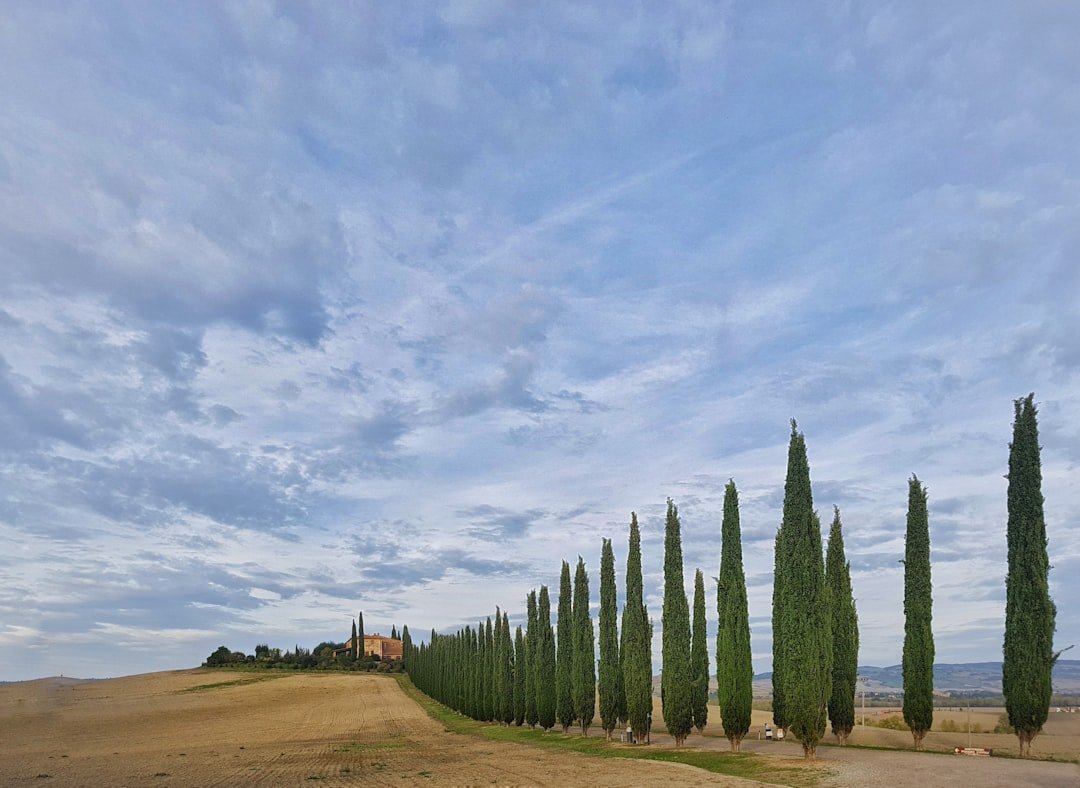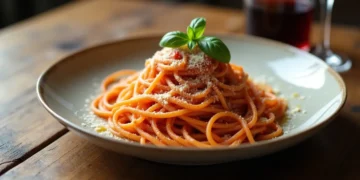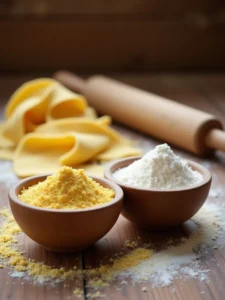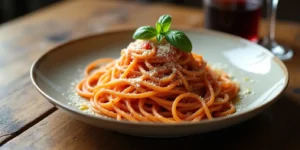
Have you ever taken a bite of pasta so perfect it felt like a little piece of Italy landed on your plate? The silky texture, the delicate bite of al dente noodles, and the aroma of a rich, flavorful sauce—these moments stay in our memory for years.
Creating that unforgettable pasta experience isn’t just about luck. It’s a combination of quality ingredients, proper technique, and a few insider tricks that even professional chefs swear by. The good news? You don’t need to dine at a five-star Italian restaurant to enjoy authentic, restaurant-quality pasta—you can make it in your own kitchen.
In this guide, we’ll uncover the secrets to perfect pasta and share expert tips on how to cook pasta like a pro, from choosing the right ingredients to finishing your dish like a chef.
Ready to transform your pasta game? Let’s dive in!
Why Quality Pasta Ingredients Matter
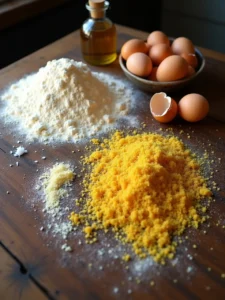
Perfect pasta begins long before you boil the water—it starts with the ingredients. Using high-quality pasta and fresh ingredients is essential if you want to achieve authentic Italian flavors. Premium durum wheat semolina, fresh eggs, and well-crafted dried pasta provide the ideal texture and taste.
Think of it this way: pasta is a simple dish, which means every detail counts. Cheap, low-quality pasta often turns mushy, breaks apart, and lacks that signature bite, while bronze-cut pasta with a rough surface holds sauce better and delivers that perfect al dente feel. Choosing the right base sets the stage for pasta perfection.
Semolina vs. 00 Flour – Which Is Best for Homemade Pasta Dough?
When it comes to crafting the perfect pasta dough, your choice of flour matters more than you might think. Two popular contenders dominate the world of pasta making: semolina flour and 00 flour. Each brings its own unique qualities to the table, and understanding their differences will help you create the texture you crave.
Semolina flour, made from durum wheat, is known for its slightly coarse texture and rich, golden color. This flour gives pasta a hearty bite and a rustic, traditional feel—perfect for robust sauces like ragù or bolognese that need a noodle with character. It also helps the pasta grip sauces better, thanks to its rough surface.
00 flour, on the other hand, is the darling of Italian kitchens for creating smooth, silky dough. This ultra-fine flour is often used for delicate pasta shapes, like tagliatelle, fettuccine, or filled pasta such as ravioli and tortellini. It produces tender, elegant noodles that pair beautifully with lighter sauces, such as butter and sage or a simple olive oil drizzle.
Which one is better? There’s no wrong answer—it all depends on the dish you’re planning. For hearty, rustic recipes, go with semolina. For refined, delicate pasta that melts in your mouth, 00 flour is your best friend.
Fresh vs. Dried Pasta – Does It Really Matter?
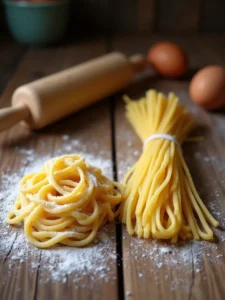
The debate between fresh pasta vs. dried pasta has been around for centuries, and here’s the truth: both have their place in Italian cuisine.
Fresh pasta is tender, delicate, and cooks in just a few minutes. Its soft texture and subtle flavor make it ideal for light sauces, cream-based dishes, and stuffed pastas like ravioli. It’s a melt-in-your-mouth experience that feels luxurious and homemade.
Dried pasta, however, is no second-class citizen. Made from durum wheat semolina, it has a firmer texture and a stronger bite, making it perfect for hearty tomato-based sauces, meat ragùs, and dishes like spaghetti Bolognese. Plus, it’s easy to store and often the go-to option for quick weeknight meals.
Bottom line: Fresh pasta brings elegance and tenderness; dried pasta delivers durability and boldness. The secret? Use each in the right context to elevate your dish.
How Do Top Italian Chefs Master the Art of Pasta?
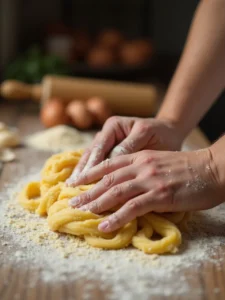
If you’ve ever wondered why restaurant pasta tastes so different from homemade, the secret isn’t just the ingredients—it’s the technique. Professional Italian chefs follow time-honored traditions to achieve that perfect bite every single time. Here are three essential steps they never skip:
1. Kneading for Elasticity and Strength
The first secret lies in the kneading process. To create perfect pasta dough, chefs work it thoroughly, using the heels of their hands to develop gluten. This step is crucial because gluten gives pasta its signature chewy texture and strength, ensuring it holds together during cooking and grips the sauce beautifully.
Think of it as giving your dough a workout—the more it’s kneaded, the smoother and stretchier it becomes. When done right, the result is pasta that feels firm yet tender with every bite.
2. Letting the Dough Rest for Maximum Pliability
In top Italian kitchens, pasta dough isn’t rushed. After kneading, it’s allowed to rest for 30 minutes to an hour, giving the gluten time to relax. This step makes the dough easier to roll out and prevents tearing, which is essential for delicate shapes like ravioli or thin sheets for lasagna.
Skipping this step is one of the most common mistakes in home kitchens. But trust the pros—resting the dough is what transforms good pasta into great pasta.
3. Rolling to the Perfect Thickness
Pasta that’s too thick feels heavy; too thin, and it falls apart. Chefs use precision and consistency when rolling their dough, often with a pasta machine set to the ideal thickness for each type. For example:
- Tagliatelle or fettuccine: medium thickness for that satisfying bite.
- Lasagna sheets: slightly thinner so they layer without overpowering the dish.
Uniformity matters—every piece of pasta should cook evenly and deliver the perfect texture on the plate.
How Does the Perfect Pasta Shape Get Crafted?
Image: crafting-perfect-pasta-shapes.webp
Title: Various pasta shapes being handcrafted, including tagliatelle, fusilli, and ravioli, on a rustic wooden surface.
Pasta isn’t just about taste—it’s about texture and how well it holds the sauce. Italian chefs know that choosing the right pasta shape can make or break a dish. Here’s how professionals craft every shape with purpose:
1. Matching Pasta Shapes to the Right Sauces
Ever wondered why rigatoni feels so perfect with a chunky tomato ragù, while spaghetti pairs beautifully with a silky carbonara? It’s no coincidence. Chefs carefully match pasta shapes to the consistency and flavor of sauces.
- Hearty, chunky sauces (like ragù or Bolognese) cling to ridged shapes such as rigatoni, fusilli, or penne rigate.
- Light, delicate sauces—think olive oil, butter, or seafood-based—shine with smooth, long shapes like spaghetti or linguine.
This simple principle ensures every bite delivers the ideal balance of pasta and sauce.
2. Cutting Noodles to the Ideal Width
Precision matters when it comes to cutting pasta. Chefs pay close attention to both width and thickness to ensure noodles cook evenly and absorb the right amount of flavor.
- Thin strands (like capellini) work best with light sauces.
- Medium ribbons (such as fettuccine or tagliatelle) pair perfectly with cream-based sauces.
- Wide noodles are reserved for rich, hearty sauces like carbonara or mushroom ragù.
Uniform cutting not only improves texture but also elevates presentation, making your dish look as stunning as it tastes.
3. Shaping Ravioli for Maximum Flavor
When it comes to stuffed pasta, like ravioli or tortellini, shape is everything. Skilled chefs press and seal each piece carefully to maximize filling capacity without risking breakage during cooking. The result? Perfectly plump pillows of pasta bursting with flavor in every bite.
How Do Restaurants Cook & Serve Pasta Like a Pro?
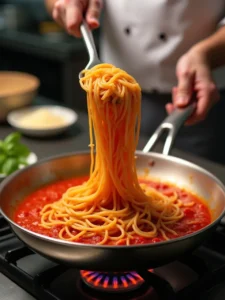 The final step in achieving pasta perfection happens at the stove—and believe it or not, professional chefs follow precise methods that go beyond just boiling water. Here’s how top restaurants cook and serve pasta for that authentic Italian experience:
The final step in achieving pasta perfection happens at the stove—and believe it or not, professional chefs follow precise methods that go beyond just boiling water. Here’s how top restaurants cook and serve pasta for that authentic Italian experience:
1. Mastering the Al Dente Texture
If there’s one golden rule for pasta, it’s this: always cook it al dente. This Italian term means “to the tooth”—firm, with just a slight bite at the center. Why? Because overcooked pasta becomes mushy and loses its character.
Chefs taste the pasta multiple times during cooking to ensure it’s just right. A good tip: remove pasta from the water about 1 minute before the package instructions suggest, as it will finish cooking in the sauce for perfect texture.
2. Saucing Pasta in the Pan for Maximum Flavor
Here’s an insider secret: the best pasta dishes aren’t made by dumping sauce on top—they’re made by tossing the pasta directly in the sauce on the stove. This step allows the noodles to absorb flavors and helps the sauce cling perfectly, thanks to the starch from the pasta water.
For an extra touch of creaminess, chefs often add a splash of starchy cooking water to the sauce while tossing. This creates a silky, restaurant-quality finish that’s impossible to achieve otherwise.
3. Why Rinsing Pasta Is a Big No-No
Many home cooks make the mistake of rinsing pasta after draining—but this is a disaster for flavor! Rinsing washes away the natural starches that help sauce stick to the noodles. Instead, chefs keep the pasta warm and slightly coated with cooking water until it’s ready to hit the sauce.
The result? Every strand, shell, or ribbon gets a beautiful, glossy coating that turns a simple dish into an unforgettable one.
Finding the Perfect Sauce Pairings
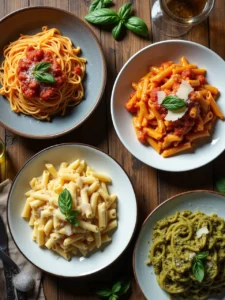
Even the most perfectly cooked pasta can fall flat without the right sauce. Professional chefs know that sauce should complement the pasta—not overpower it. That’s why they focus on simple, fresh ingredients and balance.
One of the biggest secrets? Finishing pasta in the sauce. Instead of tossing cooked noodles on a plate and pouring sauce over the top, chefs allow pasta to simmer for a minute in the pan with its sauce. This step lets the noodles soak up all those incredible flavors, creating a harmonious dish where every bite tastes complete.
To elevate the experience even further, thoughtful garnishes like crispy breadcrumbs, freshly grated Parmesan, or a sprinkle of aromatic herbs add depth and texture, turning a simple plate of pasta into a restaurant-worthy masterpiece.
Conclusion: The Secrets to Perfect Pasta Are in the Details
Mastering pasta isn’t about complicated tricks—it’s about respect for the process. From choosing quality ingredients and kneading dough for elasticity, to pairing with the right sauce and finishing with a final touch of love, every detail matters.
When you get it right, the reward is extraordinary: pasta with a delicate bite, flavors that linger, and an experience that brings a taste of Italy to your table.
So, ready to cook pasta like a pro? Grab your favorite ingredients, follow these expert tips, and transform your next meal into a true Italian delight!

















